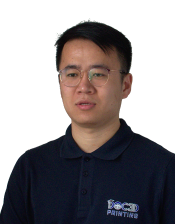ESR04 - Qirong Chen
|
|
Nationality: |
Chinese |
|
Host Institution: |
CRIBC, Belgium | |
|
Supervisor: |
Fabrice Petit, CRIBC | |
|
Subject: |
Ceramic Formulation for novel hybrid 3D Printers |
Background:
Qirong graduated from the Master degree of Materials Chemistry and Mineralogy, University of Bremen (Germany) in 2018. His master dissertation ‘Influence of composition of photo-polymerizable ceramics slurry on properties of printed products by stereolithography’ was carried in Keramische Werkstoffe, Technology University of Berlin.
In his master period, he also gained experiences on precursor derived ceramic materials treated by freeze casting and freeze drying, evaluate the corrosion resistance of silver pellets by cycle-voltammetry after self-assembled mono-layer (SAMs), specific XRD diffraction and refinement training.
His Bachelor degree was in Light Chemical Engineering and his bachelor dissertation was about ‘Effect of synergistic flame retardant of nickel catalyst on flame retardancy of polypropylene’. Different projects also have been carried in this period, such as oil-water separator with physical mechanisms, chemical plant design with different target product by Aspen Plus.
Since 2018, he is working as an Early-Stage Researcher for the DOC-3D-PRINTING project on ‘Ceramic Formulation for novel hybrid 3D Printers’ in Belgium Ceramic Research Centre (BCRC) and Université Polytechnique des Hauts-de-France (UPHF).
Presentation of the individual project:
Ceramics materials are applied widely because of excellent properties,such as hardness, refractoriness, thermal conductivity, weathering resistance, biocompatibility for bioceramics, high dielectric constant for some technical ceramics. However, different drawbacks also limit the usage of ceramics, like brittleness, low toughness, low impact strength, difficult to shape the materials and also crystallization at high temperature.
Additive Manufacturing (AM) is considered as a competitive method to shape ceramic materials compared with conventional methods. Binder jetting is one of the most promising method in AM because of its advantages, faster and flexible process, more cost-efficient than others, variety choices of materials with larger products’ size.
However,low packing density, low sintered density and poor finish surface are main drawbacks of Binder Jetting which should be improved and enhanced intensively. The main reason for these drawbacks is the coarse powders used in binder jetting (>20 µm) from literature. In order to overcome the limitations mentioned above, a novel hybrid binder jetting machine was designed by BCRC and OPTEC (Frameries, Belgium, 7080). There are laser and UV – light set up which could operate the surface finish and post-consolidation with UV – light ink in new machine. Volumetric spray device is set in order to apply the slurry spray method to create layers in future. There are still other improvements to be operated. Different parameters of powder and binder will be evaluated in order to do the optimization, together with process parameters. Then the new approach from binder jetting will also be tested to see the effect.


